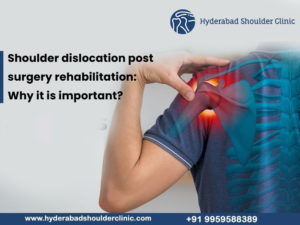The purpose of shoulder replacement surgery is to remove arthritic parts of the shoulder joint. The shoulder joint comprises a ball and socket. The ball, also called the humeral head, is attached to the humerus, and the socket is a part of the shoulder blade.
A traditional shoulder replacement surgery mimics the natural shoulder anatomy: the shoulder socket, also called glenoid, is replaced with a cup-shaped prosthetic made of plastic, and the humerus head(the top of the upper arm bone) is replaced with a “metal ball.” But in case of a reverse total shoulder replacement, the positions of the socket and the ball are swapped. The plastic cup is attached to the upper end of the humerus, and the metal ball is fixed to the socket.
People with arthritic shoulders and a large tear in the rotator cuff are often candidates for reverse total shoulder replacements because it relies on different cuff muscles for movement. In a healthy shoulder, your arm is stabilized by the rotator cuff muscles and gives power to the joint during movement. The rotator cuff muscles are also utilized by conventional replacement devices to ensure proper joint functioning.
When a patient suffers from a large rotator cuff tear or cuff tear arthritis, these muscles don’t work anymore. In such cases, reverse total shoulder replacement is suggested because the prosthetics rely on the deltoid muscles for movement and positioning instead of the rotator cuff.

An orthopaedic shoulder surgeon might consider a reverse shoulder replacement if you have:
- A rotator cuff that is completely torn and can’t be restored
- Cuff tear arthritis or arthropathy
- An unsuccessful shoulder replacement in the past
- Shoulder pain that is severe and making it difficult to lift your arm over your head or out of your side
- A complex shoulder fracture or severe trauma
- Frequent shoulder dislocations
- A tumour that affects the shoulder joint
- Conventional treatments like rest, medications, steroid injections and physical therapy don’t relieve shoulder pain.
Pain Management after reverse shoulder replacement
It is normal to experience some pain after surgery for a few days. The body naturally heals itself in this way. However, doctors and nurses will help you to minimize pain and to recover faster after surgery.
Usually, a short-term pain relief medication will be prescribed following surgery. Post-surgical pain can be managed using a wide range of medications, including opioids (painkillers), nonsteroidal anti-inflammatory drugs (NSAIDs), and local anaesthesia. These medications may be used in combinations by your doctor to relieve pain and reduce the need for opioids.
Though opioids help relieve pain post-surgery, they are narcotics and have the potential to be addictive. Dependency and overdose of opioids are becoming a severe problem in the health industry. You should only use opioids according to a doctor’s instructions. Stop taking opioids after your pain starts to improve. Consult your doctor if you are still experiencing pain after a week from the surgery.
After Reverse Shoulder Replacement Surgery
Immobilization of the joint: After the surgery, you may need to wear a sling that helps you to stabilize and immobilize your shoulder. It is best to have friends and family around for the first few days so that they can help you with basic tasks.
Limited mobility: It may take you a few weeks to be able to lift your arm over your head after surgery. Organize your home so that virtual objects are on lower shelves or counters, where they are easily accessible. In patients with degenerative conditions, it may not be possible for them to regain their full range of motion. However, the existing condition may be improved once they heal completely after surgery.

Medication: You may be prescribed antibiotics after shoulder surgery to prevent infection and pain medications to relieve pain.
Rehabilitation exercises: After surgery, your physician generally begins stretching and pendulum movements to facilitate a limited range of motion. Make sure you build strength and protect healing tissues by working with a physical therapist during your recovery. Within 4-6 weeks following surgery, most of the patients begin practising more advanced strengthening exercises.
Cold compression therapy: Doctors sometimes recommend cold and compression therapies to boost the healing process. Active compression helps to reduce oedema as well as cellular waste products present in the affected shoulder joint. In contrast, the therapeutic cold helps reduce swelling initially and reduce pain during the recovery process.
Follow-up visits: As part of your initial visit, your doctor may order x-rays and some other exams to check whether your recovery is going well.
Recovery success: The degree of pain you feel after several months may be mild or completely absent, depending on the extent of your original injury. Many people experience the full range of motion after recovery.
To know more about reverse shoulder replacement surgery or if you are experiencing any other problem with your shoulder, contact Dr Chandra Sekhar, one of the best shoulder surgeons in Hyderabad. Call +9199595 88389 to book an appointment.





